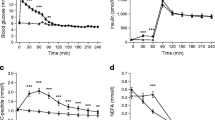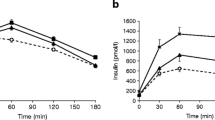Summary
It has been proposed that hyperinsulinaemia may cause or exacerbate insulin resistance. The present studies were undertaken to test this hypothesis in man. Glucose utilization, glucose production, and overall glucose metabolism at submaximally and maximally effective plasma insulin concentrations (∼80 and ∼1700 mU/l), and monocyte and adipocyte insulin binding were measured in normal volunteers on two occasions: once after 40 h of hyperinsulinaemia (25–35 mU/l) produced by infusion of insulin and once after infusion of saline (75 mmol/l; plasma insulin ∼10 mU/l). After 40 h of hyperinsulinaemia, glucose utilization and overall glucose metabolism at submaximally and maximally effective plasma insulin concentrations were both slightly, but significantly, reduced compared with values observed after the infusion of saline (p<0.05), whereas glucose production rates were unaffected. Monocyte and adipocyte binding were also unaffected. These results indicate that hyperinsulinaemia of the magnitude observed in insulin resistant states, such as obesity, can produce insulin resistance in man. Assuming that human insulin sensitive tissues possess spare insulin receptors and that monocyte and adipocyte insulin binding accurately reflect insulin binding in insulin-sensitive tissues, the decreased maximal responses to insulin and the lack of change in insulin binding suggest that this insulin resistance occurred at a post-binding site.
Article PDF
Similar content being viewed by others
References
Karam J, Grodsky G, Forsham P (1963) Excessive insulin response to glucose in obese subjects as measured by immunochemical assay. Diabetes 12: 196–204
Olefsky J (1976) The insulin receptor: its role in insulin resistance of obesity and diabetes. Diabetes 25: 1154–1163
Gavin J, Roth J, Neville D, De Meyts P, Buell D (1974) Insulin dependent regulation of insulin receptor concentrations. A rapid demonstration in cell culture. Proc Natl Acad Sci 71: 84–88
Roth J, Kahn C, Lesniak M, Borden P, De Meyts P, Megyesi K, Nevill D, Gavin J, Soll A, Freychet P, Goldfine I, Bass R, Archer J (1976) Receptor for insulin, NSILA-S, and growth hormone. Application to disease states in man. Recent Prog Horm Res 31: 95–139
Marshall S, Olefsky J (1980) Effects of insulin incubation on insulin binding, glucose transport, and insulin degradation by isolated rat adipocytes. Evidence of hormone-induced desensitization at the receptor and postreceptor level. J Clin Invest 66: 763–772
Stevens J, Atkinson R, Pohl S (1980) Insulin-induced insulin resistance of lipolysis in human adipocytes in organ culture. J Clin Endocrinol Metab 51: 921–924
Kolterman O, Insel J, Saekow M, Olefsky J (1980) Mechanisms of insulin resistance in human obesity. Evidence for receptor and postreceptor defects. J Clin Invest 65: 1272–1284
Pedersen O, Hjollund E (1982) Insulin receptor binding to fat and blood cells and insulin action in fat cells from insulin-dependent diabetics. Diabetes 31: 706–715
Harrison L, King-Roach A (1976) Insulin sensitivity of adipose tissue in vitro and the response to exogenous insulin in obese human subjects. Metabolism 25: 1095–1101
Nagulesparan M, Savage P, Unger R, Bennett P (1979) A simplified method using somatostatin to assess in vivo insulin resistance over a range of obesity. Diabetes 28: 980–983
Amatruda J, Newmeyer M, Clang C (1982) Insulin-induced alterations in insulin binding and insulin action in primary cultures of rat hepatocytes. Diabetes 31: 145–148
Kobayashi M, Olefsky J (1979) Effect of experimental hyperglycaemia on intracellular glucose metabolism of isolated adipocytes. Diabetologia 17: 111–116
Doberne L, Greenfield M, Schulz B, Reaven G (1981) Enhanced glucose utilization during prolonged glucose clamp studies. Diabetes 30: 829–835
Rizza R, Mandarino L, Gerich J (1981) Dose-response characteristics for effects of insulin on production and utilization of glucose in man. Am J Physiol E360–E634
Olefsky J (1976) Decreased insulin binding to adipocytes and circulating monocytes from obese subjects. J Clin Invest 57: 1165–1172
DeBodo R, Steele R, Altszuler N, Dunn A, Bishop J (1963) On the hormone regulation of carbohydrate metabolism: studies with C14 glucose. Recent Prog Horm Res 19: 445–488
Boyum A (1968) A one-stage procedure for isolation of granulocytes and lymphocytes from human blood. Scand J Clin Lab Invest 21 (Suppl 97): 51–76
Yam L, Li C, Crosby W (1971) Cytochemical identification on monocytes and granulocytes. Am J Clin Pathol 55: 283–290
De Meyts P (1976) Insulin and growth hormone receptors in human cultured lymphocytes and peripheral blood monocytes. In: Blecker M (ed) Methods of receptor research. Dekker, New York, pp. 301–383
Pedersen O, Hjollund E, Beck-Nielsen H, Linkskov H, Sonne O, Gleimann J (1981) Insulin receptor binding and receptor-mediated insulin degradation in human subjects. Diabetologia 20: 636–641
Rodbell M (1964) Metabolism of isolated fat cells. I. Effects of hormone on glucose metabolism and lipolysis. J Biol Chem 239: 375–380
Hirsch J, Gallian E (1968) Methods for the determination of adipose cell size in man and animals. J Lipid Res 9: 110–119
Herbert V, Lau K, Gottlieb C, Bleicher S (1965) Coated charcoal immunoassay of insulin. J Clin Endocrinol Metab 25: 1375–1384
Kobayashi M, Olefsky J (1978) Effect of experimental hyperinsulinemia on insulin binding and glucose transport in isolated rat adipocytes. Am J Physiol 235: E53-E62
Martin C, Desai K, Steiner G (1983) Receptor and postreceptor insulin resistance induced by in vivo hyperinsulinemia. Can J Physiol Pharmacol 61: 802–807
Trimble E, Weir G, Gjinovci A, Assimacopoulos-Jeannet F, Benzi R, Renold A (1984) Increased insulin responsiveness in vivo and in vitro consequent to induced hyperinsulinemia in the rat. Diabetes 33: 444–449
Horton ES, Wardzala L, Hirshman M, Pofcher E, Horton ED (1983) Chronic hyperinsulinemia increases insulin binding and insulin-stimulated glucose transport and metabolism in the rat without altering insulin sensitivity. Diabetes 32: 25 A
Bjorntorp P, Sjostrom (1978) Carbohydrate storage in man: speculation and some quantitative considerations. Metabolism 27: 1853–1865
Service F, Nelson R, Rubenstein A, Go V (1978) Direct effect of insulin on secretion of insulin, glucagon, gastric inhibitory polypeptide and gastrin during maintenance of normoglycaemia. J Clin Endocrinol Metab 47: 488–493
Insel J, Kolterman O, Saekow M, Olefsky J (1980) Short-term regulation of insulin receptor affinity in man. Diabetes 29: 132–139
Mott D, Howard B, Bennett P (1979) Stoichiometric binding and regulation of insulin receptors on human diploid fibroblasts using physiologic insulin levels. J Biol Chem 254: 8762–8767
Le Marchand-Brustel Y, Jeanrenaud B, Freychet P (1978) Insulin binding and effects in isolated soleus muscle of lean and obese mice. Am J Physiol 234: E348-E358
Bonen A, Tan M, Watson-Wright W (1981) Insulin binding and glucose uptake differences in rodent skeletal muscle. Diabetes 30: 72–704
Mandarino L, Baker B, Rizza R, Genest T, Gerich J (1984) Infusion of insulin impairs human adipocyte glucose metabolism in vitro without decreasing adipocyte insulin receptor binding. Diabetologia 27: 358–363
Bar R, Gorden P, Roth J, Kan C, De Meyts P (1976) Fluctuations in the affinity and concentrations of insulin receptors on circulating monocytes of obese patients. Effects of starvation, refeeding and dieting. J Clin Invest 58: 1123–1135
Author information
Authors and Affiliations
Rights and permissions
About this article
Cite this article
Rizza, R.A., Mandarino, L.J., Genest, J. et al. Production of insulin resistance by hyperinsulinaemia in man. Diabetologia 28, 70–75 (1985). https://doi.org/10.1007/BF00279918
Received:
Revised:
Issue Date:
DOI: https://doi.org/10.1007/BF00279918




